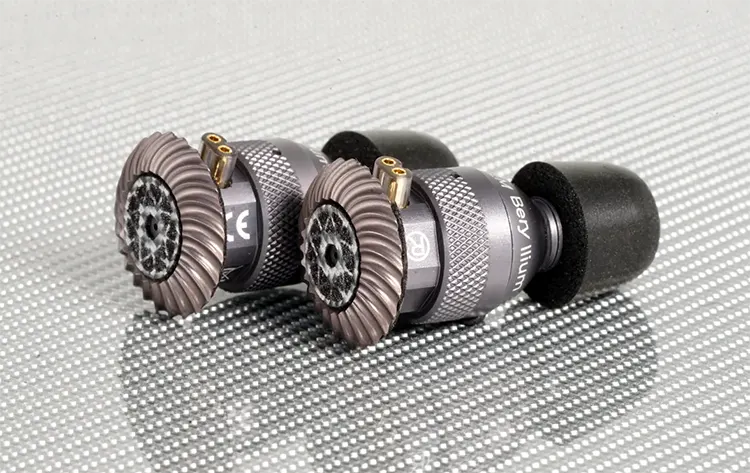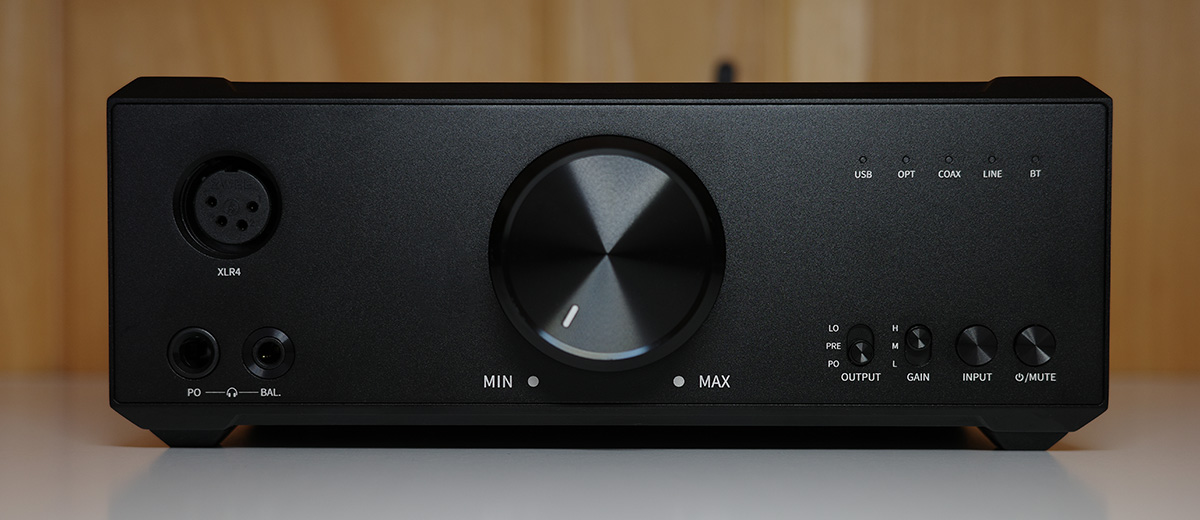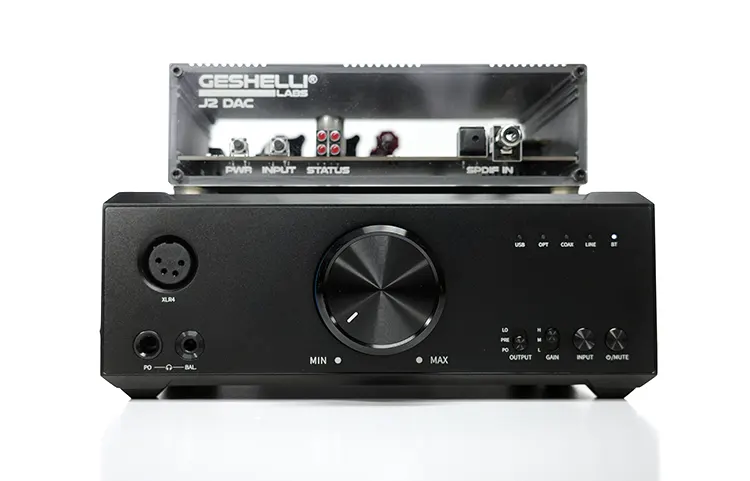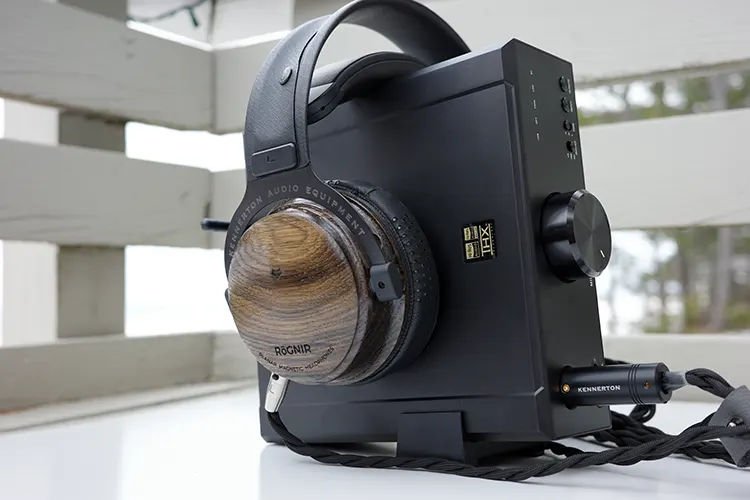Sound Impressions
Listening was done through the following devices and systems over approximately four weeks.
Headphones in use were the AKG 240DF, ZMF Eikon, Kennerton Rognir, and FiiO’s own FT3, (350Ω). IEMs included the Empire Ears Legend EVO, the Campfire Audio Supermoon Custom, and the Spirit Torino Twin Pulse IEM.
Powered speakers were the Klipsch The Sixes, while two-channel systems included the Yamaha A-S301 through the KEF Q150 speakers and a Denon PMA-770 through the Klipsch forte ii speakers. Sources included my iPhone for BT, the Shanling M6 Pro, and a MacBook Pro.
Summary
The K9 AKM seemingly oozes an organic, natural sound, but with good detail present. Warmer, and richer in sound, the notes while thicker also produce a good level of clarity. Some songs come across with a crispness in sound, but this is more about the song, than that of clarity.
Headphones that carry some weight to their signature pair quite well with the sound, while IEMs will shine on the lower gain settings. Headphones that require more power will work. However, when you move to the hardest-to-drive headphones, I wish there was more power.
For instance, the 600 ohm AKG 240DF sounded good, but not great, needing an extra boost. Conversely, FiiO’s FT3 (350Ω) and ZMF’s Eikon (300Ω) sounded quite lively with decent vibrancy. Different signatures for sure, but presentations that both excelled through the K9 AKM.
The lower impedance for IEMs helped carry both the Empire Ears Legend X and Spirit Torino IEM well, allowing the individual characteristics of each model to shine through.
Timbre
The warmer, richer signature of an AKM certainly shows here and makes for a good complimentary signature to the K9 Pro ESS. Smooth and organic in sound, you can tailor that a bit using the filters on the app.
The bass range is still very good, and using FiiO’s FT3 350Ω, the bass reached low, with very good control.
With a robust low-end, you might think the AKM carries that signature into the mids. It doesn’t, making the transition smoothly allowing the naturalness to flow unencumbered.
I will add that if a headphone or IEM is on the bass-lighter side, the FiiO will not add copious amounts of low-end; but rather allow what is present to be natural and experiential.
A lengthier decay than attack makes for the lingering effect adding to the warmth presented, but without becoming slushy or muddled.
Timbre carries that low-end through the mids with good accuracy, but not like an ESS set would. That is not the point of this unit, a musical experience is. When using IEMs, the presence is better in my opinion than the headphones I used, but not by much.
This to me shows that your listening source is as important as the unit played through; but not in a manner that limits what you use. Complimentary, additive, or allowing would be a good modus operandi regarding the presentation.
Percussion carries that lingering effect, adding girth to the notes, but was under control. Succinct intros to drums pair well with the slight slowing of release, helping the AKM convey richness.
Any coloration carries two-fold: from the headphones used and the warmth wrought from the K9 AKM.
Staging & Dynamics
The soundstage is fairly cubic, with no huge margin in any of the 3D directions.
This is not an intimate soundstage, though. Excellent height allows the layering to be displayed in detailed sound quality. The width allows for very good separation and imaging, all the while, the depth allows good placement.
Dynamically speaking, the K9 AKM shows its mettle by having a very good range across the spectrum. This is where the depth shines, allowing for those layers and separation to have good girth and thickness.
The ability to show this seems a bit counter to an AKM unit, but the THX+ amplifier does show vibrant characteristics, which could aid in what I am hearing.
The definition of notes works in concert with that slower decaying backside though, giving clarity to the signature of headphones, which carry a somewhat mid-forward signature or crispness to them.
Running the balanced jacks helps to show off the above-mentioned qualities. But the 6.35mm single-ended jack also showed good quality to itself.
Female vocals tend to sound open with a bit of airiness to them, which can help carry the spacious feeling in the depth and width while moving slightly up; adding height. No wispiness was had, as the vocals stayed true to the artist, with excellent clarity.
Wireless Connectivity
Bluetooth
The Bluetooth pairing process with the K9 AKM is straightforward. Simply press the input button until the BT LED light pops up then search for it on your transmitting source, whether it is a DAP, laptop, or smartphone.
For Windows, it’s equally fast at detecting but you will get two options, device, and audio, make sure you pick the headphones icon for audio.
You should find the K9 AKM label right away then click to pair to complete the process. Once paired, double-check the audio quality settings on your source. Make sure it is set to best performance or LDAC. so you are not restricted to aptX only for receiving on the K9.
The FiiO Control app is not restricted to the BT input mode either. The K9 AKM BT is constantly on when the unit is active so if your transmitting source has its BT signal active you can find the unit and pair with it via the app even if in USB mode for example.
From there you can control whatever input mode you wish to have or even switch it to standby mode. The FiiO is a BT receiver only, thus physical connectivity to powered speakers (or your two-channel system) is needed when using a BT source.
The range is limited by the source used, and thus quite variable. On my iPhone 13 Pro Max, the range went over 15m. On the Cayin N6ii, about 10m.
Latency
Using my MacBook Pro to stream video content, the results were good, but not great. I found the sound quality adequate, but the K9 AKM’s BT soundstage depth was lacking in three-dimensionality.
Delays were very tight, and I blame the YouTube/streaming quality as much as anything. I did not feel the need to adjust anything when playing music videos, or streaming content.
Wired Connectivity
USB-DAC Pairings
You can bypass the K9 AKM DAC and get a taste of the THX788+ amp on its own. This is a clean-sounding but also fairly transparent amplifier with the tested DAC’s signature tweaking the output performance.
Using the affordable Geshelli Labs JNog2 through the XLR-4 balanced connection, which uses the ES9026Pro, provided a more vibrant signature than the K9 AKM, but without thinning the note quality.
I appreciate the tuning of the Geshelli and could see this as a semi-permanent solution for a variety of tuning flavors. I also concur with Marcus in his assessment that a quality desktop DAC option should be implemented if you add an external DAC.
When paired through my desktop two-channel system and streaming from sources; the K9 AKM performed admirably. Having the capability to adjust the content through the FiiO app, or on the two-channel system gives the user added abilities.
When switching around your source, you get a fair idea of the built-in DAC sonic profile, and the K9 AKM leans towards a warmer, richer signature DAC sound with a bit of coloration. With that warmer signature, you can understand that it is a less precise rendition than an ESS-based unit.
Coax
This was the connection I used the most, along with the optical into either my powered speakers or two-channel system.
The ability of the K9 AKM coax to connect the sources I used made it quite adaptable. Most units come with a multitude of connection options, so, organizing your desktop with the requisite connectivity cables is a must if you prefer to change often.
RCA
I only used this for a shorter time, connected to my older Denon integrated amplifier into my main two-channel system.
The ability to hook up an analog connection also worked with older DAPs, through their 3.5mm single-ended jack. I was able to use my older Dethonray DTR1 Prelude in this manner, and the result was very pleasing.
Known for an extremely accurate signature, the DTR1 complimented the K9 AKM, balancing both “in-house” signatures making for a very good listen.
Synergy
Efficiency
Much like the K9 Pro ESS, you can expect a good result from IEMs, since the same THX788+ amplifier is used on the K9 AKM.
Only on the high gain setting did I hear any less-than-black background and that was only with the planar driver Campfire Audio Supermoon.
When using anything below high gain on the Supermoon, no hiss was heard to me. Mind you the sound was fabulous through the pairing, regardless. Once the music starts, any discernible hiss goes by the wayside.
FiiO kept the output impedance below 1Ω for both balanced and unbalanced connections so those with monitors sensitive to high impedance skew will not have anything to worry about when plugging them into the K9 AKM.
The volume knob is very linear in response too, and you can go from very, very quiet to very loud quite gradually.
Moving the gain to low gives you excellent fine-tuning ability when using your IEMs, as a result. This is one of the smoothest operating volume knobs I have used.
IEM Pairings
The K9 AKM pairs well with vibrant IEMs, even if the signature of the unit is a bit on the warmer side. The Supermoon is detailed, with crisp clarity and a touch of warmth, and the FiiO allowed the musicality of the Supermoon to come through with an excellent response.
Jazz piano pieces were detailed and dripping with emotion. But in a manner that allowed the best of both to come through.
I found this to be one of my favorite pairings and played this duo quite a bit across many differing genres. Male vocals came through with excellent breadth and note weight. Meaty, but with an edginess to it, which allowed those details to shine.
When paired with the AKM, the Spirit Torino IEM Twin Pulse midrange is the highlight of the show, perhaps lifted and moved to the front a bit more.
The detail coming forth is right where I remembered, and very good. Vocals come to the forefront as a result of that tuning, which may hinder some listeners’ liking.
Not quite as bassy as the Supermoon, the smooth top end means you can raise the volume well beyond what the Supermoon offers, though. There is a bit of holography to the sound when paired with the FiiO, which makes for a broader stage, which is appreciated.

Power
Not meant for higher impedance headphones, the K9 AKM did quite well, nonetheless. This may be oriented towards headphones since it is a desktop unit, but IEM usage should not be discounted. Especially with the three gain settings.
Besides the above-mentioned IEMs, the harder-to-drive Empire Ears Legend EVO worked well, allowing the darker signature to shine through with plenty of power.
Plus, harder-to-drive headphones worked up to a point. While the 350Ω FT3 played quite well, the 300Ω ZMF Headphones Eikon worked, but not quite as well needing more volume to attain the same level of volume, by ear.
Once you move past that level of impedance, the K9 AKM struggles a bit. I completely understand this and would recommend your lower-impedance headphones and some IEMs instead.
Headphone Pairings
The FiiO FT3 (350 ohm) seems to work quite well with the K9 AKM. While harder to drive, with the gain on high, there was still plenty of headroom for adjusting the volume to my delight.
Running the volume pot slightly over halfway and on high gain gave me a pleasing level of volume paired with very good detail.
The higher impedance model comes with a good, detailed sound with which to start, and the additive effect I mentioned above comes about when paired with the K9 AKM.
Not the most detailed of the lot here, the pairing still resulted in a fun, energetic signature with a slightly dark side. Reggae sounded quite good with the duo. Female vocals sounded a touch warmer as well, making for a good evening pairing when called upon.
The ZMF headphones Eikon is 300Ω, but it is less sensitive than the FT3 through the K9 AKM and requires a bit more volume. I found the mids came alive but became a bit brittle or harsh when called upon too much.
I am sensitive to upper-frequency sounds at high volume, so this to me comes at the price of pleasant listening. Discarding that, the level of detail and clarity shone through, with a slightly lower reach of bass, but less quantity than the FT3.








